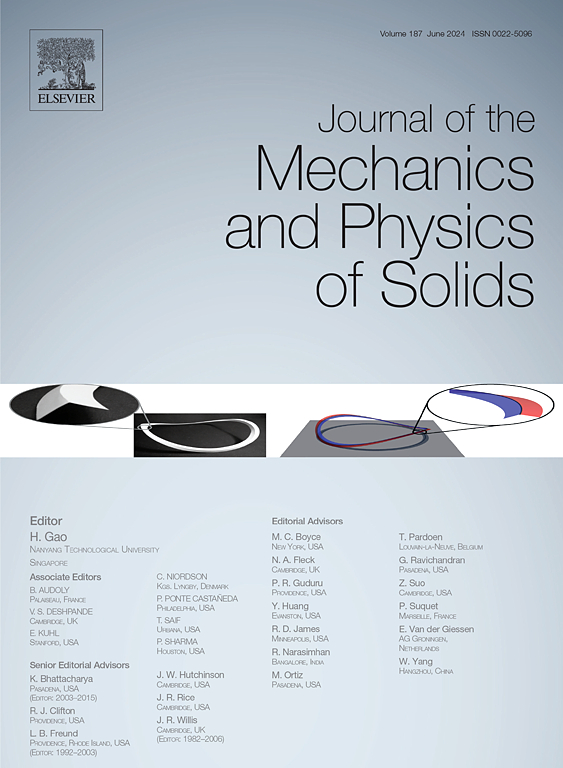仿生交错复合材料的有效机械响应:通过微力学变分公式的封闭形式估计
IF 6
2区 工程技术
Q2 MATERIALS SCIENCE, MULTIDISCIPLINARY
引用次数: 0
摘要
与传统复合材料相比,交错微结构的仿生复合材料具有优越的机械性能,为先进功能材料的发展铺平了道路。现有的分析模型主要采用平面应变或平面应力假设来求解沿交错方向的宏观尺度本构响应。因此,在等效材料在三轴加载情况下的响应表征方面仍然存在显著的差距。本研究提出了一种微力学变分公式,以推导出仿生交错复合材料各向异性均化行为的分析和综合表征。微尺度平衡问题,适合于一个合适的代表性体积单元,是通过对总势能泛函应用平稳条件来解决的,在一类准相容的应变场上进行评估,这些应变场捕获了主要的微尺度运动学。线性化技术导致封闭形式的表达式,充分表征材料的宏观刚度张量。通过参数化算例,将得到的解析结果与有限元模拟、理论解和边界进行了比较。结果证实了所提公式的有效性,证明了所得到的分析估计的一致性和准确性。本文章由计算机程序翻译,如有差异,请以英文原文为准。
Effective mechanical response of biomimetic staggered composites: Closed-form estimates via a micromechanical variational formulation
Bio-inspired composite materials with staggered microstructures exhibit superior mechanical properties compared to traditional composites, paving the way for the development of advanced functional materials. The existing analytical models mainly address the macroscale constitutive response along the staggering direction using plane strain or plane stress assumptions. Consequently, a significant gap remains in the characterization of the equivalent material response in triaxial loading scenarios. This study presents a micromechanical variational formulation to derive an analytical and comprehensive characterization of the anisotropic homogenized behavior of biomimetic staggered composites. The microscale equilibrium problem, tailored to a suitable representative volume element, is tackled by applying stationary conditions to the total potential energy functional, evaluated over a class of quasi-compatible strain fields that capture the dominant microscale kinematics. A linearization technique leads to closed-form expressions that fully characterize the macroscale stiffness tensor of the material. Through a parametric case study, the obtained analytical results are compared with finite element simulations and theoretical solutions and bounds. The results confirm the validity of the proposed formulation, demonstrating the consistency and accuracy of the obtained analytical estimates.
求助全文
通过发布文献求助,成功后即可免费获取论文全文。
去求助
来源期刊
CiteScore
9.80
自引率
9.40%
发文量
276
审稿时长
52 days
期刊介绍:
The aim of Journal of The Mechanics and Physics of Solids is to publish research of the highest quality and of lasting significance on the mechanics of solids. The scope is broad, from fundamental concepts in mechanics to the analysis of novel phenomena and applications. Solids are interpreted broadly to include both hard and soft materials as well as natural and synthetic structures. The approach can be theoretical, experimental or computational.This research activity sits within engineering science and the allied areas of applied mathematics, materials science, bio-mechanics, applied physics, and geophysics.
The Journal was founded in 1952 by Rodney Hill, who was its Editor-in-Chief until 1968. The topics of interest to the Journal evolve with developments in the subject but its basic ethos remains the same: to publish research of the highest quality relating to the mechanics of solids. Thus, emphasis is placed on the development of fundamental concepts of mechanics and novel applications of these concepts based on theoretical, experimental or computational approaches, drawing upon the various branches of engineering science and the allied areas within applied mathematics, materials science, structural engineering, applied physics, and geophysics.
The main purpose of the Journal is to foster scientific understanding of the processes of deformation and mechanical failure of all solid materials, both technological and natural, and the connections between these processes and their underlying physical mechanisms. In this sense, the content of the Journal should reflect the current state of the discipline in analysis, experimental observation, and numerical simulation. In the interest of achieving this goal, authors are encouraged to consider the significance of their contributions for the field of mechanics and the implications of their results, in addition to describing the details of their work.

 求助内容:
求助内容: 应助结果提醒方式:
应助结果提醒方式:


